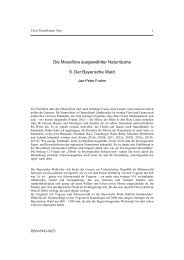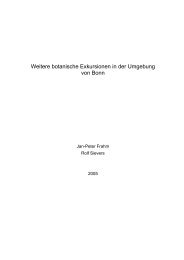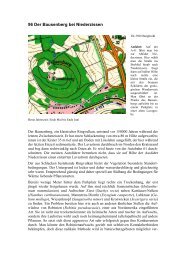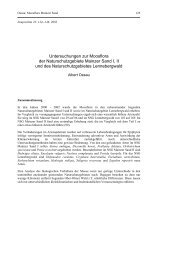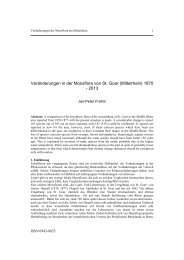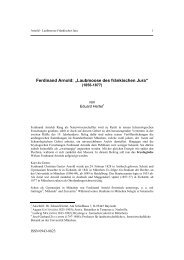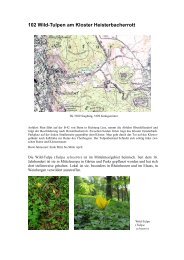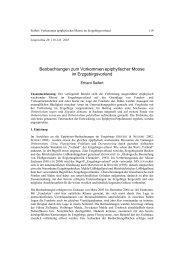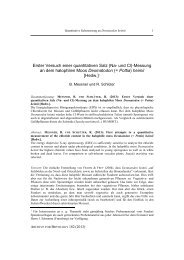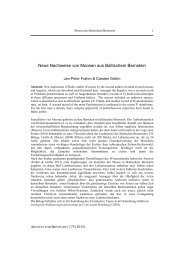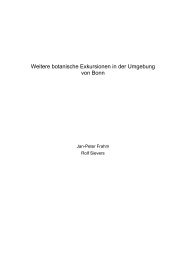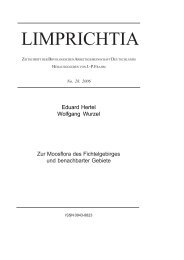Archive 40.pdf - Jan-Peter Frahm
Archive 40.pdf - Jan-Peter Frahm
Archive 40.pdf - Jan-Peter Frahm
You also want an ePaper? Increase the reach of your titles
YUMPU automatically turns print PDFs into web optimized ePapers that Google loves.
ARCHIVE FOR BRYOLOGY 40 (2009)<br />
Infraspecific taxa of Hypnum cupressiforme<br />
A preliminary study of the infraspecific taxa of Hypnum<br />
cupressiforme in Europe<br />
<strong>Jan</strong>-<strong>Peter</strong> <strong>Frahm</strong><br />
Abstract: Field observations of mixed tufts demonstrate that Hpynum cupressiforme s.str. (excl.<br />
imponens, jutlandicum, andoi etc.) consists of several different genotypes which are no<br />
modifications. Within a study of herbarium material, the specimens were sorted into different<br />
phenotypes, for which names were applied from the literature. Within Hypnum cupressiforme, an<br />
expression with straight leaves (var. brevisetum Schimp.) was distinguished as well three with<br />
hamate leaves (var. uncinulatum Boul., var. cupressiforme and var. plumosum Mart.), which are<br />
differentiated by the size, number and form of alar cells and serrate viz. entire leaf tips. Var.<br />
subjulaceum is tentatively regarded as alpine variety of Hypnum lacunosum, var, filiforme is<br />
regarded as modification based on the oberservation of transitions.<br />
Introduction<br />
Hypnum cupressiforme is a cosmopolitan species (Wijk et al. 1964), but has its main distribution<br />
in Laurasia. In North America, it consists of only one medium sized phenotype. In contrast, the<br />
species shows in Europe by a high variability. This does not only concern taxa which are regarded<br />
as separate species such as H. jutlandicum, H. lacunosum, H. resupinatum or H. andoi by different<br />
authors on different levels and with different synonymies, but also within H. cupressiforme s.str.<br />
Field observation of mixed stands reveal that there are at least several different genotypes within<br />
H. cupressiforme s.str.<br />
A possible explanation for the lack of variability of Hypnum cupressiforme in North America and<br />
the great variability of this species in Europe could be that the species has undergone genetic<br />
differentiation in Europe during the Ice Ages in the Pleistocene. Because of the E-W barriere of<br />
the Alps, the temperate species survived in different refugia in southern Europe, where they were<br />
separated from each other for one to two hundred thousand years. Due to the lack of such a barrier<br />
in North America, the populations of the species were not separated during the Ice Age but had<br />
gene exchange.<br />
1
2<br />
<strong>Frahm</strong><br />
Fig. 1. Fig. 2.<br />
Figs. 1-2: Mixed stands of different expressions of Hypnum cupressiforme. 1. A large and a small<br />
form growing interwoven on a rock. France Dépt. Belfort, Lac de Alfeld, <strong>Frahm</strong> 3.9.01 s.n.; 2. A<br />
large and a small form growing on the same tree trunk. Germany, Nordrhein-Westfalen, Rhein-<br />
Siegkreis, Siebengebirge, <strong>Frahm</strong> 5773.<br />
Several attempts have been made to sort the different phenotypes of Hypnum cupressiforme.<br />
Described by Hedwig in 1801 (based on an earlier publication), all expressions have been<br />
summarized in one species and more or less many infraspecific taxa for almost 150 years. The<br />
authors of the Index Muscorum (Wijk et al. 1964) list 84 varieties, of which 27 are accepted.<br />
Over the time but mainly during the last decades, former varieties such as the vars. lacunosum.<br />
resupinatum, ericetorum, mamillatum, imponens, uncinulatum and canariense have been<br />
segregated and were treated by some authors of floras on a species level. For example, In the<br />
Netherlands, two species (jutlandicum, cupressiforme) were accepted (Touw & Rubers 1989), in<br />
Britain three (cupressiforme, jutlandicum, mamillatum, Smith 1978) and in Germany (<strong>Frahm</strong> &<br />
Frey 1987) five species (cupressiforme, jutlandicum, lacunosum, mamillatum, resupinatum).<br />
Reason for the high number of species distinguished in Germany was the fact that all species show<br />
– except for morphological and anatomical differences, also different ecological preferences and<br />
ranges. Hypnum lacunosum is characteristic for chalk grassland, jutlandicum for heathland and<br />
conifer forests, mamillatum (=andoi) is an epiphyte in beech forests and resupinatum has a strong<br />
oceanic range.<br />
Special attention on the infraspecific taxa of Hypnum cupressiforme was paid by Doignon (1950).<br />
He gave a detailed account of the authors and number of taxa recognized within H. cupressiforme,<br />
discussed the value of the taxa and characters and distinguished (except for varieties presently<br />
accepted as species) the vars. uncinatum (typicum), longirostrum, brevisetum, subjulaceum and<br />
filiforme.<br />
Barkmann (1966) based his publication on Doignon (1950) and distinguished the same taxa.<br />
Later Ando published a series of seven papers on the genus Hypnum. In a survey of the European<br />
taxa (Ando 1985), he treated H. imponens, H. andoi, H. uncinulatum and H. jutlandicum as<br />
ISSN 0945-3466
ARCHIVE FOR BRYOLOGY 40 (2009)<br />
Infraspecific taxa of Hypnum cupressiforme<br />
separate species. Within H. cupressiforme he distinguished the vars. lacunosum, julaceum,<br />
subjulaceum, filiforme and resupinatum.<br />
Within a special study of H. cupressiforme (Ando 1987), the author treated Hypnum<br />
cupressiforme with nine varieties (var. subjulaceum, var. resupinatum, var. filiforme, var.<br />
lacunosum, var. julaceum, var. mossmannianum, var. yashanicum, var. townsendii and var.<br />
cupressiforme). Within the var. cupressiforme, Ando distinguished 12 forms: typical. terete,<br />
complanate, slender loose, pinnate, small, large, aduncoides, homomallous, pendulous filescent,<br />
subfiliform and partly filiform.<br />
Hedenäs (1991) treated the Hypnum cupressiforme complex in Sweden and distinguished four<br />
species (resupinatum, mamillatum, jutlandicum and cupressiforme). Three years later (Hedenäs<br />
1994) in survey of the Hypnum cupressiforme in Switzerland, he treated them as subspecies<br />
(resupinatum, mamillatum, cupressiforme, ericetorum). In both cases, the variation within H.<br />
cupressiforme s.str. was not considered.<br />
On which taxonomic level these taxa are distinguished, as species (Hedenäs 1991), or subspecies<br />
(Hedenäs 1994) is a matter of taste. However, if they are “only” regarded as varieties, a chance is<br />
missed to differentiate the genotypes within H. cupressiforme s.str.<br />
Recent results of molecular studies based on ISSR markers and ITS and trnL sequences of<br />
specimens of the Hypnum cupressiforme complex from Italy (H. jutlandicum, andoi, resupinatum,<br />
lacunosum, cupressiforme, Spagnuolo et al. 2008) revealed that all taxa except for H. jutlandicum<br />
were mixed up in the dendrogram. This does not exclude that other more suitable markers allow to<br />
separate infraspecific taxa of Hypnum cupressiforme s.str. However, these units derived from<br />
molecular data need not automatically correspond with phenotypes. Regardless the results of the<br />
molecular studies, alpha-taxonomic studies are still required for field bryology. Therefore an<br />
attempt has been made in order to find well delimited infraspecific taxa within Hypnum<br />
cupressiforme based on herbarium material and field observations..<br />
The presence of mixed stands (figs. 1-2) shows that the different phenotypes of Hypnum<br />
cupressiforme are mostly not modifications but different genotypes. In such cases two different<br />
expressions are developed in the same habitat under the same ecological conditions (sun, shade,<br />
substrate, inclination etc.). Genotypes, especially if they look so different as in the present case,<br />
deserve taxonomic recognition, especially if they have different ecological preferences or different<br />
ranges.<br />
In the author´s personal opinion, the genotypic variability within H. cupressiforme s.str. requires a<br />
distinction of taxa. Therefore a provisional attempt has been made based on the specimens in the<br />
author´s herbarium (BONN). For that purpose small samples of herbarium specimens were glued<br />
on small file cards and then sorted by similarity. The specimens within these groups were then<br />
described and compared with descriptions in the literature that a name could be applied for these<br />
taxa. As expressed in the title, the study is provisionally. The types of the varieties have not been<br />
studied, the priority of names was not checked and the study was based on a relatively small<br />
number of specimens. Main purpose was to see whether the enormous variability within this<br />
species can be grouped into distinguishable taxa and to get names for these taxa, or whether<br />
intermediates prohibit the distinction of varieties.<br />
Infraspecific taxa of Hypnum cupressiforme in Europe<br />
In the following, Hypnum cupressiforme is treated in a narrow sense exclusively H. imponens,<br />
jutlandicum, lacunosum, andoi, uncinatulum, resupinatum (cf. Frey et al. 2006). Several of these<br />
species are distinguished by sporophytic characters: H. andoi with mamillate lid, H. resupinatum<br />
with longly rostrate lid, H. uncinatulum with ovoid capsules. Hypnum imponens differs by its<br />
pseudoparaphyllia, H. lacunosum by the shape of the laminal cells and H. jutlandicum by the<br />
leaves serrate all around.<br />
3
4<br />
<strong>Frahm</strong><br />
Within the remaining H. cupressiforme s.str., distinct genotypes could be distinguished by the size<br />
of the leaves, the number and shape of the alar cells and entire vs. serrulate leaf tips:<br />
1. Leaves hamate, homomallous.<br />
2 Leaves 1-1.2 mm long and 0.4 mm wide, alar cells 10-15.<br />
var. uncinulatum<br />
2*. Leaves larger, alar cells more numerous.<br />
3. Leaves 1.5-2 mm long. Leaf tips serrulate.<br />
var. cupressiforme<br />
3*. Leaves 2.3-2,7 mm long, Leaf tips entire.<br />
var. plumosum<br />
.. 1* Leaves straight var. brevisetum<br />
Var. cupressiforme (Fig. 4, 9c)<br />
Hypnum cupressiforme var. uncinatum Boul.<br />
Leaves 1,5-2 mm long and
ARCHIVE FOR BRYOLOGY 40 (2009)<br />
Infraspecific taxa of Hypnum cupressiforme<br />
Rarely specimens are observed, which have branches with straight leaves on plants with curved<br />
leaves (Fig. 6). They show that the characters curved and straight are genetically fixed.<br />
Fig. 6: Hypnum cupressiforme var. cupressiforme with straight as well as hamate leaves (France,<br />
Gironde, Grayan-L´Hoptal, De Sloover 28403).<br />
Specimens examined: Britain: Scotland, Argyll, Morvern, <strong>Frahm</strong> 7.7.1978. Danmark, Jütland,<br />
Ulfborg Planatage, epiphytic, <strong>Frahm</strong> 24.7.1975. France, Dept. Haute-Saône, on wall, <strong>Frahm</strong><br />
V5668; Eisenbahnbrücke zw. Luxeuil und Vesoul, <strong>Frahm</strong> 23.3.1992; Dépt. Vosges, zwischen La<br />
Montagne und Le Val d´Ajol, <strong>Frahm</strong> 30.7.93; Remiremont, on walls of fort, <strong>Frahm</strong> 27.3.1992.<br />
Germany, Baden Württemberg, Heidelberg, Glime 8091; Nordrhein-Westfalen Kr. Kempen-<br />
Krefeld, Munitionsdepot Bracht, on trunk, <strong>Frahm</strong> 10111; Kr. Kleve, Schaephuysen, epiphytisch,<br />
<strong>Frahm</strong> 9791; Rhein-Siegkreis, Siebengebirge, Löwenburg, <strong>Frahm</strong> 8.12.1996; Kr. Monschau,<br />
Rurtal, on rock, <strong>Frahm</strong> 4.7.07; Kr. Siegburg, Brenig bei Bornheim, Quarzsandgrube, <strong>Frahm</strong><br />
11146; Rheinland-Pfalz Kr. Bernkastel-Wittlich, Windsborner Maar, on lava rocks, <strong>Frahm</strong> 99907;<br />
Kr. Ahrweiler, Dungskopf bei Remagen, on basalt with var. plumosum, <strong>Frahm</strong> 16.11.1994;<br />
Kammerslei bei Kesseling, on schist, <strong>Frahm</strong> 9786; Reutersley bei Rheineck, on schist, <strong>Frahm</strong><br />
9598; Staatsforst Adenau bei Herschbach, on schist, <strong>Frahm</strong> 10069; Kr. Neuwied, Ober-<br />
Hammerstein, on schist, <strong>Frahm</strong> 9674; Hummelsberg bei Linz, on basalt, <strong>Frahm</strong> 30.6.02; Idar-<br />
Oberstein, Kammerslei, on rock, <strong>Frahm</strong> 13.4.1996. Baden-Württemberg, Kr. Lindau, Eistobel,<br />
<strong>Frahm</strong> 10.3.1973. Crete, Chania, Schlucht zwischen Skines und Neo Roumata, <strong>Frahm</strong> K-140;<br />
Elos, Straßenand, <strong>Frahm</strong> K-238; Madeira, Paúl da Serra, Posto Florestal Estanquinhos, on rock,<br />
<strong>Frahm</strong> M-143, M 145. Spain, Asturia, Munoz 4012.<br />
Small forms: Germany, Nordrhein-Westfalen Kr. Düren, Jülih, epiphytic, <strong>Frahm</strong> 12.3.1994;<br />
Rheinland-Pfalz Kr. Ahrweiler, Reutersley bei Rheineck, on oak, <strong>Frahm</strong> 9597; Kempenich, on tufa<br />
5
6<br />
<strong>Frahm</strong><br />
rock, <strong>Frahm</strong> 9787; Kr. Bernkastel-Wittlich, Lieser Tal S Manderscheid, on schist, <strong>Frahm</strong> 9915; Kr.<br />
Koblenz, Stadtwald, epiphytic, <strong>Frahm</strong> 9934. France, Dépt. Haute-Saône, Valbert, on rock, <strong>Frahm</strong><br />
V5680; Dépt. Vosges, Hamanxard. epiphytic, <strong>Frahm</strong> V5781; Aude, Montagne Noir, De Sloover<br />
45.207.. Crete, Chania, along road Sougia – Nea Roumata, <strong>Frahm</strong> K-123;<br />
Var. uncinulatum B.S.G. (Fig. 3,9a)<br />
non H. uncinulatum Jur. (=H. canariense Mitt.)<br />
Plants small, only up to 2,5 cm long and only 0.4 – 0.8 mm wide. Leaves 1-1.2 mm long and 0.4<br />
mm wide, in the lower part oval-ovate, suddenly contracted into a long homomallous tip which is<br />
entire. The upper part is as long or longer than the lower part. Alar cells few, 12-15, of which 5-10<br />
are inflated, incrassate, brownish. Laminal cells incrassate, almost straight, not sinuose, 40-60 x 3-<br />
4µm, 12-20 x longer than wide.<br />
Similar to the typical variety with regard to the leaf shape and branching, but only half size. The<br />
lid is described as longly rostrate, which may indicate the independent status of this taxon, because<br />
the var. cupressiforme has a conical lid with a beak (and H. andoi, previously treated as H.<br />
cupressiforme var. mamillatum, a blunt lid with a mamilla). Ando (1985) names it “small form”<br />
and refers it with some doubt to var. uncinulatum, since he has not seen the type.<br />
Ecology: on base and nutrient poor rock (schist, trachyt, tufa), also epiphytic, 200 – 500 m alt.<br />
There exists some nomenclatural confusion with the epithet uncinulatum. This taxon was<br />
described as variety of H. cupressiforme in the Bryologia Europaea in 1854 but Juratzka in 1866<br />
described a species as new under the same name. The name was then misspelled by Lange in 1869<br />
as uncinatulum. Later Limpricht in 1899 synonimized var. uncinatum Boul. with var. uncinulatum<br />
Hypnum uncinulatum Jur. is very similar to this variety with the same name, but is an endemic of<br />
the Macaronesian Islands and was also found in Ireland. It differs by the ellipsoid capsules with a<br />
wide mouth when empty, a serrulate leaf tip, very long and narrow laminal cells (25:1) and 6-8<br />
alar cells of which two are inflated. Hypnum andoi also has a strong resemblance to this variety<br />
but has a blunt (mamillate) lid.<br />
Mixed stands were found with var. plumosum which demonstrates that the small size is not<br />
induced by nutrient poor habitats and on the other hand the large forms a result of base rich and<br />
nutrient rich habitats.<br />
Specimens examined: Germany: Rheinland-Pfalz, Kr. Ahrweiler, zw. Herschbach und Kesseling,<br />
<strong>Frahm</strong> 9788; Kempenich, Steinrausch, <strong>Frahm</strong> 9712; Langfigtal bei Altenahr, <strong>Frahm</strong> 11277;<br />
Vinxtbachtal, <strong>Frahm</strong> 5606; Kr. Mayen, Nitztal, <strong>Frahm</strong> 3940; France: Dépt. Haute-Saône, Valbert,<br />
<strong>Frahm</strong> V5679; zwischen Froideconche und Valbert, <strong>Frahm</strong> V 5682; Dépt. Vosges Moseltal<br />
oberhalb Lepange, <strong>Frahm</strong> 11.4.1991. Poland, Gorce, Bryotheca Polonica no. 1100.<br />
Var. plumosum (Fig. 5, 9d)<br />
Hypnum semi-revolutum C. Müll. ?<br />
Stereodon cupressiforme var. pinnatum Warnst.<br />
Largest variety. Plants robust, to more than 10 cm long and 2 mm wide, usually light green to<br />
yellowish or golden green, more or less regularly branched. Leaves strongly hamate, the tips<br />
sometimes twisted, 2,3-2,7 mm long and 1,2 mm wide, from ovate base suddenly contracted to a<br />
narrow hooked tip, which is shorter than the basal part. Leaf apex entire. Alar cells yellowish<br />
brown, strongly collenchymatous, consisting of 20-30 larger and 10-20 smaller ,lighter coloured<br />
cells. Laminal cells 60-75 x 4-5 mm.<br />
According to Ando (1985), this variety intergrades with H. lacunosum, In fact, H. lacunosum has<br />
about the same size and can have a similar appearance, but it has shorter and wider laminal cells<br />
and stems not attached by rhizoids to the substrate.<br />
ISSN 0945-3466
ARCHIVE FOR BRYOLOGY 40 (2009)<br />
Infraspecific taxa of Hypnum cupressiforme<br />
Ecology: on (base rich) rocks e.g. basalt, limestone, concrete, also on clay. Distribution perhaps<br />
more southern in Europe.<br />
Specimens examined: Madeira, Paúl da Serra, <strong>Frahm</strong> M-144; Austria: Kärnten, Plöckenpass ,<br />
<strong>Frahm</strong> 2007361. Germany, Schleswig-Holstein, Nordstrand, Eternitdach, Abts 13.7.1994;<br />
Nordrhein-Westfalen Kr. Düsseldorf-Mettmann, Angerbachtal, Steinbruch, <strong>Frahm</strong> 20.3.1973; Kr.<br />
Köln, Wahner Heide, <strong>Frahm</strong> 9188; Rhein-Siegkreis, Siebengebirge, Stenzelberg, <strong>Frahm</strong><br />
13.5.1995; Niederpleis, Tongrube, <strong>Frahm</strong> 14.11.1998; Rheinland-Pfalz Kr. Ahrweiler, Dungskopf<br />
bei Remagen, on basalt with var. cupressiforme, <strong>Frahm</strong> 16.11.1994. France, Puy de Dome, O´Shea<br />
28.8.1982; Dépt. Haute Vaucluse, Bollène, <strong>Frahm</strong> 14.3.2000. Spain, Burgos, Munoz 2463;<br />
Mallorca, Lewinsky 18.4.1970. Greece, Samos, Düll 24.6.1996.<br />
var. brevisetum Schimp. (Figs. 7-8, 9b)<br />
var. strictifolium (Warnst.) als var. von Stereodon cupressiformis<br />
var. ovatum Ren. & Card.?<br />
var. longirostrum Schimp. ?<br />
teret form sensu Ando 1989 ?<br />
Plants small, dark to grey green, up to 1 mm wide and 2 cm long. Leaves almost straight, ca. 0.8<br />
mm long and 0.3 mm wide, sometimes slightly hooked on stem or branch tips, with broadly ovate<br />
base. more or less gradually narrowed into a straight and smooth tip. Alar cells 10-15, dark green,<br />
incrassate. Median laminal cells about 4 x 40 µm. Setae less than 1 cm long. Capsule longly<br />
rostrate. Warnstorf (1906) gives an excellent description of this variety.<br />
This taxon differs markedly from all other varieties, having the appearance rather of a Pylaisia<br />
polyantha than a Hypnum cupressiforme. Specimens of Hypnum resupinatum are very similar and<br />
often misidentified but can be distinguished in the field by the upright turned leaves. Ando (1985)<br />
mentions no orthophyllous taxa in his treatment of the European taxa of Hypnum cupressiforme<br />
s.lat. but mentions a terete form (Ando 1989), which shall often be transitional to the typical form.<br />
However, mats with orthophyllous plants and uncinate plants are found growing together on the<br />
same tree trunk (fig. 7).<br />
The name refers to a short seta, which is rarely present, however, Warnstorf´s epithet strictifolium<br />
is more characteristic but has no priority.<br />
Ecology: Usually on bark of deciduous trees, also on acidic rocks (schist, trachyt).<br />
Var. longirostrum is described as having straight leaves and a long operculum (Doignon 1950) and<br />
may belong to this taxon. Doignon (l.c.) calls it a transitional form. Warnstorf (1906) describes it a<br />
weakly hamate, which seems to support Doignon´s view. The leaves are slightly longer as in var.<br />
brevisetum (up to 1,4 mm) and the apex shall sometimes be indistinctly serrulate, both again<br />
intermediate between var. brevisetum and var. cupressiforme.<br />
Specimens examined: France, Dept. Haute-Saône, Valbert, epiphytic, <strong>Frahm</strong> V5681; Germany,<br />
Nordrhein-Westfalen, Kr. Euskirchen, Fringshaus bei Blankenheim, on poplar, <strong>Frahm</strong> 5.4.91; Kr.<br />
Mettmann, Urdenbacher Kämpe <strong>Frahm</strong> 11303; Schlackenhalde bei Bruchhausen, epiphytic, <strong>Frahm</strong><br />
9921; Rhein-Sieg-Kreis, Drachenfels, <strong>Frahm</strong> 3922; Ölberg, <strong>Frahm</strong> 26.3.1995; Rheinland-Pfalz Kr.<br />
Cochem-Zell, Klotten, <strong>Frahm</strong> 10177, 10178; Kr. Bernkastel-Wittlich, Lieser Tal S Manderscheid,<br />
on schist, <strong>Frahm</strong> 9850. Netherlands, Brabant, Boxmeer, on Fraxinus, <strong>Frahm</strong> 8.4.07; Gelderland,<br />
Waardenburg, <strong>Frahm</strong> 3.7.1975 det. Ando as H. cupressiforme terete form.<br />
7
8<br />
Fig. 7: Hypnum cupressiforme, var. plumosum<br />
and var. brevisetum from the same tree trunk<br />
<strong>Frahm</strong><br />
a b c d<br />
Fig. 8: Hypnum cupressiforme var.<br />
brevisetum (<strong>Frahm</strong> 11303)<br />
Fig. 9: Leaf sizes and Leaf shapes of Hypnum cupressiforme a. var. uncinulatum, b. var.<br />
brevisetum, c. var. cupressiforme, d. var. plumosum.<br />
Excluded taxa<br />
Var. subjulaceum described by Molendo from the Alps is a glossy plant with ascendend stems, no<br />
rhizoids and straight, densely imbricate leaves. The leaves are up to 2 mm long und 0.6 mm wide.<br />
The laminal cells measure 40-50 x 4-6 µm.<br />
The dimensions of the laminal cells. lacking rhizoids and imbricate leaves suggest that this variety<br />
could be an alpine expression of Hypnum lacunosum.<br />
Var. resupinatum (Tayl.) Schimp.has been treated as species (Frey et al. 2006 amongst others). It<br />
differs only slightly from var. brevisetum by the leaves turned upwards and would not require the<br />
status of a species. Since this taxon has a distinct range in the oceanic parts of western Europe, in<br />
contrast to the varieties described above, which have not distinct ranges, it is kept as species.<br />
ISSN 0945-3466
ARCHIVE FOR BRYOLOGY 40 (2009)<br />
Infraspecific taxa of Hypnum cupressiforme<br />
The status of var. filiforme is doubtful. Although regarded as a variety by most authors,<br />
observations in the field reveal that it can be just a modification of pendent plants. As shown by<br />
transitions between plants grown horizontally (e.g. on the surface of branches and rocks) and<br />
pendant (Fig. 10,11). On the other hand, not all Hypnum mats grown vertically are filiform, there<br />
are also normally developed forms on vertical tree trunks or rocks. As in other pendant forms, this<br />
seems to be an effect of high humidity. In many cases, Hypnum andoi has been taken for H.<br />
cupressiforme var.filiforme in the past. Also Ando (1985) argues that the vars. cupressiforme and<br />
var. filiforme often intergrade and therefore var. filifome might be a habitat modification. On the<br />
other hand, forms such as var. filiforme do not exist in western North Americas and Japan (except<br />
for few specimens from soil!). In these regions the humidity should be sufficient to produce<br />
filiform modifications.<br />
Fig. 10: Hypnum cupressiforme var.<br />
cupressiforme on a horizontal branch (<strong>Frahm</strong><br />
V5781a)<br />
Fig. 11: Hypnum cupressiforme mod. filiforme<br />
pendant from the same branch as in fig. 8<br />
(<strong>Frahm</strong> V 5881b)<br />
Discussion<br />
Ando (1985) described “forms” which are in part modifications and can in part be attributed to the<br />
varieties mentioned here. The “partly filiforme, pendulous filescent, pinnate, slender, subfiliform<br />
and slender loose forms” are probably modifications. the large form as well as var. aduncoides<br />
resemble var. plumosum. Var. uncinulatum as well as var. uncinatum is regarded as synonym of<br />
var. cupressiforme,<br />
Doignon (1950) as well as Barkman (1966) distinguish no typical variety, which was perhaps<br />
hardly possible without having seen the type specimen of Hypnum cupressiforme. According to<br />
their keys, var. uncinatum resembles the type. The vars. subjulaceum and var. brevisetum are the<br />
only varieties with straight leaves and the same of the present study. Var. longirostrum could not<br />
be attributed.<br />
A general problem is that the taxa of the Hypnum cupressiforme complex show parallel<br />
modifications. Thus Hypnum andoi, Hypnum cupressiforme var. uncinulatum und Hypnum<br />
cupressiforme mod. filiforme are very similar appearence when growing on vertical trunks of trees<br />
ans can only be differentiated by sporophytic or microscopical gametophytic characters.<br />
Mönkemeyer (1927) lists (except for the taxa nowadays accepted as species) three varieties: var.<br />
crispatissimum, var. filiforme and var. subjulaceum. Var. crispatissimum could be the var.<br />
plumosum of this study, var. filiforme includes a fo. uncinatula, which is identical with the<br />
9
10<br />
<strong>Frahm</strong><br />
var.ununcinulatum of the present study and var. subjulaceum covers all expressions with straight<br />
leaves inclusive Hypum resupinatum.<br />
Warnstorf (1906), who is known for his excessive use of infraspecific taxa, distinguishes (again<br />
except for the taxa accepted today as species) the vars. brevisetum, uncinatulum and plumosum as<br />
in the present study, and in addition the vars. filiforme, longirostris and subjulaceum (= strictum,<br />
orthophyllum).<br />
References<br />
Ando, H.1985. Hypnum cupressiforme Hedw. and its close allies in Europe. Abstracta Botanica 9,<br />
Suppl. 2: 11-18<br />
Ando, H. 1989. Studies in the genus Hypnum (VI). Hikobia 10: 269-291.<br />
Barkman, J. J. 1966. De varieteiten van Hypnum cupressiforme Hedw. in Nederland.Buxbaumia<br />
(Amsterdam) 20 (1-2): 1-6.<br />
Doignon, P. 1950. Ecologie et vaiations de l´Hypnum cupressiforme L. Revue Bryol.Lichénol.<br />
19 : 208-220.<br />
<strong>Frahm</strong>, J.-P., Frey, W. 1987. Moosflora, 2nd. ed. Stuttgart.<br />
Frey, W., <strong>Frahm</strong>, J.-P., Fischer, E., Lobin, W. 2006. The liverworts, Mosses and Ferns of Europe.<br />
Martins (Harley Books).<br />
Hedenäs, L. 1991. Översikt over Hypnum cupressiforme Komplexet i Sverige. Myrnia 1: 2-7.<br />
Hedenäs, L. 1994. Schlüssel für die Sippen des Hypnum cupressiforme - Komplexes der Schweiz.<br />
Meylania 6: 10-14.<br />
Mönkemeyer, W. 1927. Die Laubmoose Europas. Leipzig.<br />
Smith, A.J.E. 1978. The Moss Flora of Britain and Ireland. Cambridge.<br />
Touw, A., Rubers, W.V. 1989. De Nederlandse Baldmossen. Utrecht.<br />
Warnstorf, C. 1906. Kryptogamenflora der Mark Brandenburg Bd. 2. Leipzig.<br />
Wijk, R.van der, Margadant, W.D., Florschütz, P.A. 1964. Index Muscorum vol. 3. Utrecht,<br />
ISSN 0945-3466




